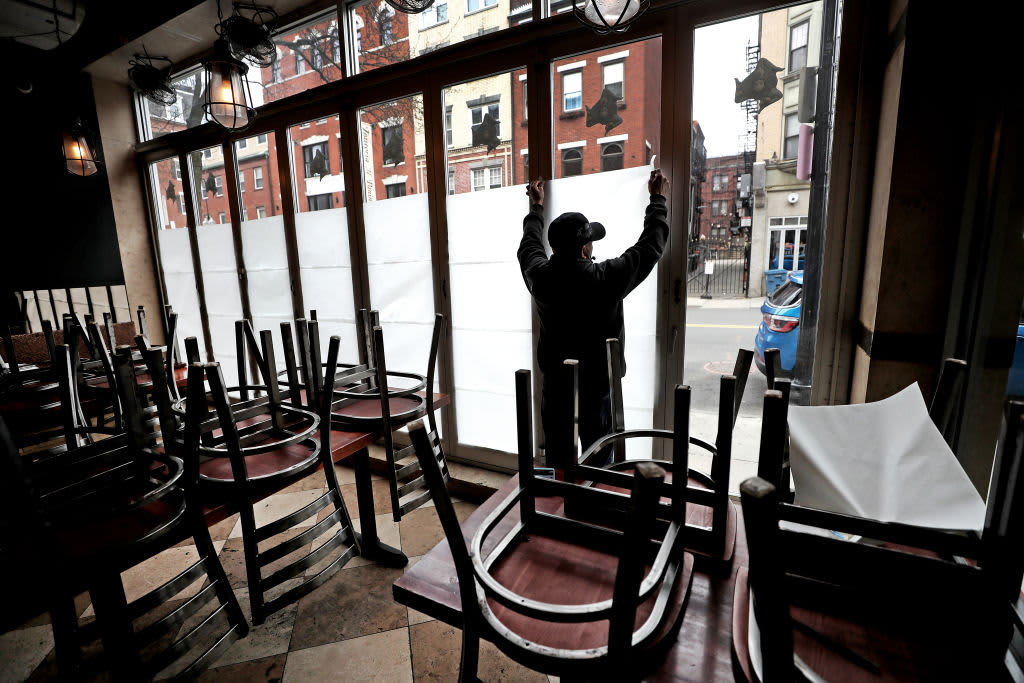An employee of Carmelina’s in the North End of Boston tapes up paper in the windows of the restaurant, which is temporarily closing during the coronavirus pandemic, on March 25, 2020.
David L. Ryan | The Boston Globe via Getty Images
There was a glimmer of hope in the dismal April jobs report in that nearly four in five workers surveyed by the government expect to return to their jobs.
However, the problem some economists see is their employers may not be able to take those workers back.
The April jobs report showed a staggering 20.5 million jobs were lost, in the most rapid labor market decline in history. The unemployment rate rose to 14.7%, and even the government said it could be closer to 20% depending on how workers are counted.
Job losses were greatest in leisure and hospitality, with 7.7 million jobs gone in that sector alone. Education and health care lost 2.5 million workers and professional and business services, and retail each lost 2.1 million jobs.
Economists say how those workers will return to their jobs is difficult to forecast, and that makes the recovery from the abrupt shutdown of the economy in late March likely to be slow and bumpy, instead of the V-shaped bounce some had once expected.
States are reopening in an uneven fashion, and the course of the virus remains uncertain, with no medical way to prevent it so far. The hardest-hit sectors are those that are most impacted by social distancing and the virus, and it may be more difficult for those businesses to return to normal any time soon.
Michelle Meyer, head of U.S. economics at Bank of America, said the fact that 18 million people interviewed by the government described their layoffs as “temporary” was a “silver lining.” The 18 million were part of more than 23 million unemployed people in the government’s household survey.
“With 78% classified as temporarily unemployed, workers should be able to be more seamlessly rehired upon reopening. But time is of the essence,” she said.
Retailers are one of the sectors struggling and while some are reopening stores, there have been some high-profile bankruptcies like J. Crew and Neiman Marcus. Economists say they will not need the staff they had before the outbreak any time soon, if ever.
“Furloughed workers don’t know whether or not they will be called back,” said Diane Swonk, chief economist at Grant Thornton. “There’s optimism that they’ll be called back. The question is will the jobs be there on the other side. … It’s a question of how many companies shut down or will have to close down on the other side of this. A lot of travel and leisure workers were furloughed.”
In that sector, restaurants and bars have taken a huge hit, and economists say the industry has already lost 5 million jobs in two months, or about half of its entire workforce.
Many of those jobs are tourism related and may be hard to recover. There’s also a ripple effect, with many firms expected to slowly bring their workers back, and the restaurants and support businesses that rely on those customers could find it difficult to get by even when they reopen.
Many companies expect to hold off on bringing the majority of their workers back into offices, leaving many at home while they reconfigure and, or reconsider their space. Alphabet’s Google, said on Friday that the majority of its workers will work from home until 2021.
The jobs report reveals the levels of pain cut across multiple sectors, including health care which was hit hard for non emergency and elective services. Some of those jobs could be slow to return because of social distancing and some may never come back because of the move toward telemedicine, Swonk said.
Economists also say that the report underscores that the federal government will need to continue plugging holes for businesses and individuals with extended aid packages, and it also may have to provide a bigger boost for state and local governments. State governments are particularly strapped by the demands of 22 million Americans collecting unemployment.
Mark Zandi, Moody’s Analytics chief economist, said the April employment report was disappointing in a number of ways.
“I came away less hopeful. Of the things I really found disconcerting, one was the massive job losses in state and local governments. That was about 1 million jobs. This suggests the states and local governments are under severe financial stress,” said Zandi. “If the federal government doesn’t come through with more help, we’re going to see more lost jobs. These are critical jobs. Those are police, fire, emergency. These are the kinds of jobs you need in a crisis. These are middle-paying jobs.”
Zandi expects millions more job losses for May, which is when he expects unemployment to peak. The losses in May should be much smaller than those in April. And he expects the employment rate to get back to about 10% by November.
“Most of those job losses so far has been due to supply shock and business shutdowns. Now we’re going to see the hit on the demand side of the economy,” he said. That will be all types of businesses impacted by consumer and business spending.
Economists say there are also lurking risks in the reopenings should there be a new wave of virus outbreaks.
“It just feels like this rapid reopening of businesses across the country is asking for trouble. The odds of another wave of infections is rising,” said Zandi. “If we have another round of the virus, this is going to go down as a depression not a recession because we’re going to be down double-digit employment for a long time.”
